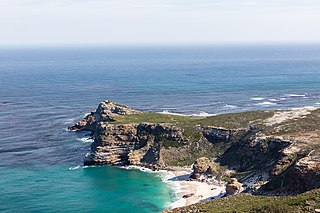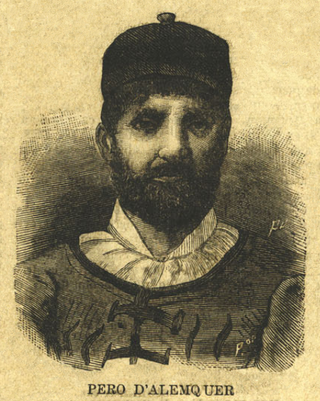Related Research Articles

The Cape of Good Hope is a rocky headland on the Atlantic coast of the Cape Peninsula in South Africa.

The history of the Kingdom of Portugal from the Illustrious Generation of the early 15th century to the fall of the House of Aviz in the late 16th century has been named the "Portuguese golden age" and the "Portuguese Renaissance". During this period, Portugal was the first European power to begin building a colonial empire as during the Age of Exploration Portuguese sailors and explorers discovered an eastern route to India as well as several Atlantic archipelagos and colonized the African coast and Brazil. They also explored the Indian Ocean and established trading routes throughout most of southern Asia, sending the first direct European maritime trade and diplomatic missions to Ming China and to Japan, at the same time installing trading posts and the most important colony: Portuguese Macau. The Portuguese Renaissance produced a plethora of poets, historians, critics, theologians, and moralists. The Cancioneiro Geral by Garcia de Resende is taken to mark the transition from Old Portuguese to the modern Portuguese language.

D. Vasco da Gama, 1st Count of Vidigueira, was a Portuguese explorer and nobleman who was the first European to reach India by sea.

Bartolomeu Dias was a Portuguese mariner and explorer. In 1488, he became the first European navigator to round the southern tip of Africa and to demonstrate that the most effective southward route for ships lies in the open ocean, well to the west of the African coast. His discoveries effectively established the sea route between Europe and Asia.

Mossel Bay is a harbour town of about 120,000 people on the Southern Cape of South Africa. It is an important tourism and farming region of the Western Cape Province. Mossel Bay lies 400 kilometres east of the country's seat of parliament, Cape Town, and 400 km west of Port Elizabeth, the largest city in the Eastern Cape. The older parts of the town occupy the north-facing side of the Cape St Blaize Peninsula, whilst the newer suburbs straddle the Peninsula and have spread eastwards along the sandy shore of the Bay.
Diogo Dias, also known as Diogo Gomes, was a 15th-century Portuguese explorer. He was the brother of Bartolomeu Dias and discovered some of the Cape Verde islands together with António Noli.

Pero de Alenquer was a 15th-century Portuguese explorer of the African coast. He was born in Alenquer and accompanied Bartolomeu Dias on his journey around the Cape of Good Hope in 1487 and 1488. Alenquer was the pilot of Vasco da Gama's flagship on the latter's first voyage to India.

Algoa Bay is a maritime bay in the Eastern Cape, South Africa. It is located on the east coast, 683 kilometres (424 mi) east of the Cape of Good Hope.

A padrão is a stone pillar left by Portuguese maritime explorers in the 15th and 16th centuries to record significant landfalls and thereby establish primacy and possession. They were often placed on promontories and capes or at the mouths of major rivers. Early markers were simple wooden pillars or crosses but they deteriorated quickly in the tropical climate where they were often erected. Later, padrões were carved from stone in the form of a pillar surmounted by a cross and the royal coat of arms.

The Casa da Índia was a Portuguese state-run commercial organization during the Age of Discovery. It regulated international trade and the Portuguese Empire's territories, colonies, and factories across Asia and Africa. Central to the Casa da Índia's objectives was the establishment and protection of a Portuguese mare clausum in the Atlantic Ocean, Indian Ocean, Arabian Sea, and the Indies.
Portuguese South Africans are South Africans of Portuguese ancestry. The exact figure of how many people in South Africa are Portuguese or of Portuguese descent are not accurately known as many people who arrived during the pre-1994 era quickly assimilated into English and Afrikaner speaking South African communities. There was likely also an undercount of immigrants, especially from Madeira.

Portuguese maritime exploration resulted in the numerous territories and maritime routes recorded by the Portuguese as a result of their intensive maritime journeys during the 15th and 16th centuries. Portuguese sailors were at the vanguard of European exploration, chronicling and mapping the coasts of Africa and Asia, then known as the East Indies, and Canada and Brazil, in what came to be known as the Age of Discovery.

Kwaaihoek is a rocky headland on the coast of Algoa Bay, at Boknesstrand near Bushman's River Mouth in the Eastern Cape province of South Africa. It is a section of the Addo Elephant National Park. It is here that the Portuguese navigator Bartolomeu Dias erected the Padrão de São Gregório, his first padrão, or stone cross on 12 March 1488. First visited by Robert Jacob Gordon on 13 February 1786, remnants of the cross were rediscovered in 1938 by E. Axelson and transferred to the University of the Witwatersrand in Johannesburg.

São Gabriel was a Portuguese carrack and the flagship of Vasco da Gama's armada on his first voyage to India in 1497–1499.

The Second Portuguese India Armada was assembled in 1500 on the order of King Manuel I of Portugal and placed under the command of Pedro Álvares Cabral. Cabral's armada famously discovered Brazil for the Portuguese crown along the way. By and large, the Second Armada's diplomatic mission to India failed, and provoked the opening of hostilities between the Kingdom of Portugal and the feudal city-state of Calicut. Nonetheless, it managed to establish a factory in the nearby Kingdom of Cochin, the first Portuguese factory in Asia.

The Portuguese discovery of the sea route to India was the first recorded trip directly from Europe to the Indian subcontinent, via the Cape of Good Hope. Under the command of Portuguese explorer Vasco da Gama, it was undertaken during the reign of King Manuel I in 1497–1499. Considered one of the most remarkable voyages of the Age of Discovery, it initiated the Portuguese maritime trade on the Malabar Coast and other parts of the Indian Ocean, the military presence and settlements of the Portuguese in Goa and Bombay.

Portugal–South Africa relations refer to the current and historical relationship between Portugal and South Africa. Nowadays the two countries have solid relations, with South Africa representing a major partner for Portugal amongst AU members.

The European-Asian sea route, commonly known as the sea route to India or the Cape Route, is a shipping route from the European coast of the Atlantic Ocean to Asia's coast of the Indian Ocean passing by the Cape of Good Hope and Cape Agulhas at the southern edge of Africa. The first recorded completion of the route was made in 1498 by Portuguese explorer Vasco da Gama, the admiral of the first Portuguese Armadas bound eastwards to make the discovery. The route was important during the Age of Sail, but became partly obsolete as the Suez Canal opened in 1869.
There are at least three statues of Bartolomeu Dias, the first European to sail around the southernmost tip of Africa. This exploration, in 1488, led to the discovery of a sea route from Europe to Asia.

The Vasco da Gama Pillar in Malindi, Kenya, was erected by the Portuguese explorer Vasco da Gama. It was constructed in 1498 or 1499 during his pioneering maritime expedition from Lisbon to India via the Cape of Good Hope (1497–99).
References
- A History of Southern Africa by Eric A. Walker (1957, 3rd edition, Longmans Green, London).
See Years in South Africa for additional References